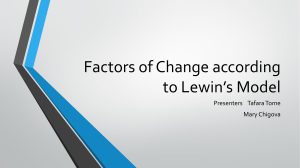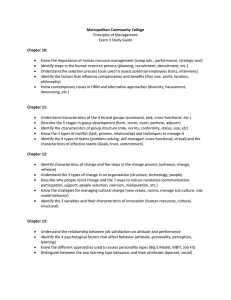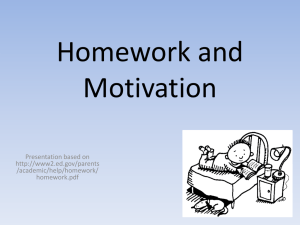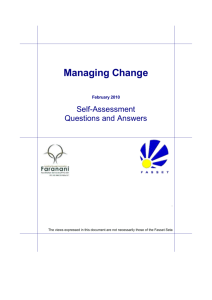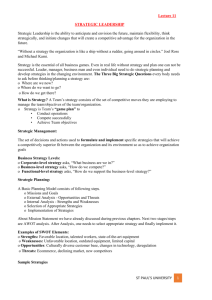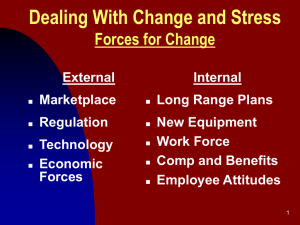Change Management –MBA625 LECTURE # 2 KURT LEWIN
advertisement
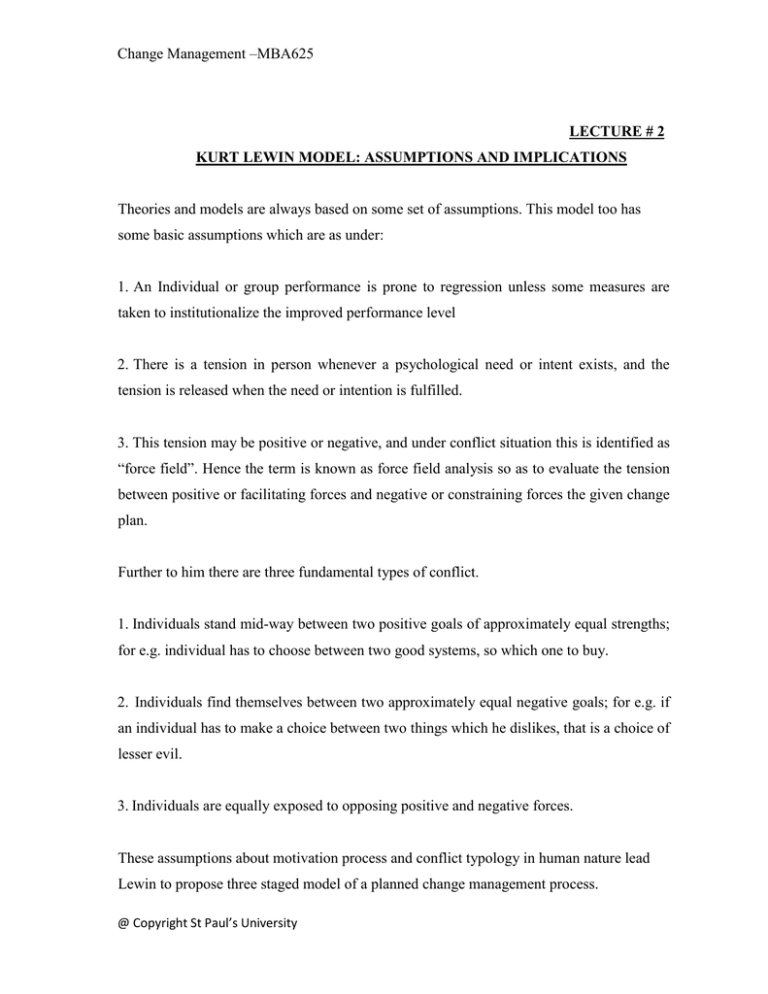
Change Management –MBA625 LECTURE # 2 KURT LEWIN MODEL: ASSUMPTIONS AND IMPLICATIONS Theories and models are always based on some set of assumptions. This model too has some basic assumptions which are as under: 1. An Individual or group performance is prone to regression unless some measures are taken to institutionalize the improved performance level 2. There is a tension in person whenever a psychological need or intent exists, and the tension is released when the need or intention is fulfilled. 3. This tension may be positive or negative, and under conflict situation this is identified as “force field”. Hence the term is known as force field analysis so as to evaluate the tension between positive or facilitating forces and negative or constraining forces the given change plan. Further to him there are three fundamental types of conflict. 1. Individuals stand mid-way between two positive goals of approximately equal strengths; for e.g. individual has to choose between two good systems, so which one to buy. 2. Individuals find themselves between two approximately equal negative goals; for e.g. if an individual has to make a choice between two things which he dislikes, that is a choice of lesser evil. 3. Individuals are equally exposed to opposing positive and negative forces. These assumptions about motivation process and conflict typology in human nature lead Lewin to propose three staged model of a planned change management process. @ Copyright St Paul’s University Change Management –MBA625 1. Unfreeze 2. Change 3. Refreeze Stage 1 Unfreeze the current equilibrium: Before going for change in first stage we have to create tension amongst the recipient of change that something is not good in the on-going system. This is to create emotional stir up which is to break the shell of complacency and self-righteousness amongst the subject of change. The reason is to break the personal defenses and group norms psychologically before actually going for change. In the words of Edgar Schein this stage consists of the following attributes: 1) The physical removal of the individuals being changed from the accustomed routines, sources of information and social relationships 2) The undermining and destruction of all social support. 3) Demeaning and humiliating experience to help individual. Being changed to see their old attitude or behavior as unworthy and thus motivated to change. Here I would like to give example of ragging of new entrants from military training. New entrants are deliberately targeted for their existing behavior, norms and identity by the senior cadets so as to acquire new way of thinking and sociology. Moreover they are deprived of social support as training academies are situated at far off places and candidates are not permitted to meet their family members. 4) The consistent linking of reward with willingness to change and of punishment. @ Copyright St Paul’s University Change Management –MBA625 rewarded. There would not be any meaningful change if the change targets perceive no linkage of reward and the desired behavior, or if the old behavior and norms are continued to be rewarded. For Schein Unfreeze stage must simultaneously couple with the following characteristics: 1. Disconfirmation of expectation 2. Induction of learning anxiety if the disconfirming data are accepted as valid and relevant. There would not be any need felt for change and learning one thinks he has already perfect knowledge, and stays confident. In other words one feels discomfort able with the existing system, performance level knowledge or state of affairs. Similarly if there is no learning anxiety individuals are least pushed for change as they getting satisfaction from the existing ones. This is also known as mind blockage when people refuse to accept new or changed reality or they are in a state of disbelief and refusing to learn the new things. 3. Provision of psychological safety that converts anxiety into motivation to change. If anxiety gets converted not fear it will be creating resistance for change. Therefore anxiety should be strong enough to be a source of motivation for change This point is very critical and crucial because if we admit something with ourselves as wrong we will lose effectiveness, self-efficacy, self-esteem or even our identity. Therefore in order to learn one has to be humble. Learning will be lower for individual with higher self-esteem and vice versa. Two types of change: 1) Action level or Symbolic 2) Belief or Cognitive Comparatively speaking change in beliefs or belief system which is also identified as @ Copyright St Paul’s University Change Management –MBA625 cognitive restructuring brings in more sustainable and meaningful change than symbolic and action type of change. Shock therapy in psychology is one such technique for changing belief of a patient. This kind of treatment is very common in our social settings. For instance parents-child relationship is based on the severity of event if father slaps his son to make him stop doing certain things. The concept of punishment is also a kind of shock therapeutic technique for behavioral modification. Similarly in real life certain events change the attitude of a person. This has application in management too. For instance organization going deficit the fear or shock of close down or job-cuts may motivate individual and groups to change and work for turn around. While action level or symbolic type manifest at extraneous to individual and at times is short lived and reflect merely compliance in outward actions of individuals or organizational practices only. In order to unfreeze mental programming is good for reducing resistance. Similarly in this stage it is suggested to establish performance- reward linkage without which change would not be sustainable. A very simple and powerful technique for motivating for change is to induce reward for performer and no reward or punishment for non-performer. This is perhaps one very good reason for change efforts to meet failure in a typical public sector organization because in such organization senior executives fail to cultivate or make people perceive such linkage to exist. Because in public sector organizations all managers (good or bad) get same increment, promotion or other benefits based on seniority or on the length of service. Therefore very convincing reforms fail to bring in behavioral change because these reforms meet with failure at the very first stage as these are unable to even unfreeze the situation 2. Change Movement This means a movement from existing to the desired form. It is a state of transition or transformation which depicts neither an old state nor a new state of affairs. This is very critical stage as it may either way backward (in case of failure) or forward. According to one author the time or stage in transition is known as “crazy period”. Generally in this phase individuals and organizations try to cope up simultaneously both systems; existing @ Copyright St Paul’s University Change Management –MBA625 and the desired one. Important thing is to follow the desired objectives or system in a consistently. Ambiguity and parallel work of old and new has to be tolerated. Initial productivity of new system is considered to be lower than the previous system. The process is to occur through two mechanisms: i) Identification – when role models are there in the environment, for e.g. individuals who can easily follow the footsteps of role model and in context of organization the popular term is bench marking – following the best practices of the industry leaders. Nations also tend to identify other nations as their model for economic or socio-political development. For instance economic development strategies of far eastern states like Korean and Chinese are cited to other developing countries for economic development. In the field of political and constitutional development often USA and UK are identified as the most democratic and political mature societies. ii). Internalization. Knowledge exists most of the time at external level. The most critical aspect is how to internalize knowledge, therefore just identification and mere knowledge is not enough. Here internalization refers to the behavioral aspect of the recipient According to one version only that is considered to be knowledge which is part of one’s behavior (reflected in action). Therefore going by this criteria knowledge of good practices is not enough unless good practices are practiced. Movement from one stage to another stage is initiated by trigger event and manager’s personalization of trigger. Mood and disposition 3. Refreeze Once the new objective or desired state of affairs has been achieved the problem with this phase is to institutionalize the new system so that people might not revert back to the older @ Copyright St Paul’s University Change Management –MBA625 ways of doing things. The purpose in this phase is to stabilize new learning. This can be done through behavioral reinforcement. In this stage again the effectiveness of performance –reward linkage is considered to be the part of enabling environment. New behavior is to be internalized. Important note here is that effects of many training programs and lectures are short lived when a person returns to the environment that does not reinforce. Hence continuous and intermittent reinforcement is needed. Another example from real life is that Pakistanis are known as highly productive abroad but back in their own society they are known as work strugglers, the difference is on account of enabling environment. Therefore in order to refreeze the new behavior, system or equilibrium we have to provide enabling environment. Application The model can be applied to all three levels to explain change management phenomenon; societal, organizational and individual. For instance our society in overall analysis is in transition phase. Older things, system and traditions have been unfrozen, but we have yet to learn the dynamics of new systems as the productivity of newly learned behavior is at lower level than the traditional system. The society is in transition from agrarian to industrial, rural to urban and traditional to modern. Members of such a society face a situation of role overload and role conflict bears attributes of both systems. We have unlearned our traditions but yet to learn modern productive traits. This transition reflects what is identified by one author as ‘crazy period’. At organizational level we can take the example of organizations undergoing an automation program. Therefore first thing is to unfreeze the mindset of managers by creating dissatisfaction about the existing system file work or manual work. So creating discomfort amongst members of organization about lower level of productivity, creating sense of urgency and instilling fear of lagging behind in competition, enlisting perceived benefits for motivating managers are various techniques for unfreezing. During the second phase of change movement once the decision is taken for automation leads to multiple problems of learning, training, jobs and position displacements, hiring of computer @ Copyright St Paul’s University Change Management –MBA625 technologist, budgetary allocations etc. will create unease and tensions in the two types of system; manual and automated one. Key to successful transformation lies in staying consistent, learning from mistake and tolerating ambiguity. And finally in the refreeze stage people get accustomed to newer system as learners and performers are rewarded. Newer behavior and work ethics are internalized. Similarly at individuals also undergo through the same stages like when they have to learn new knowledge, skills or values which are considered to be more productive. First in unfreezing stage resolving intra -individual conflict or tension, envisioning the desired state and dissatisfaction with existing levels of knowledge, skills or values. Second is to take actual steps and moving into crazy period or transition phase which is demanding in terms of learning new habits, values and commitments. Once the success is achieved individuals need to program internalize or refreeze the newly learnt values. IMPLICATIONS OF KURT LEWIN MODEL 1. Change can be directed, managed and controlled (Learning is a choice behavior) 2. There is an explicit recognition to the fact that change will be resisted 3. This resistance can be overcome thru management and good leadership 4. Sequence of event also matters 5. Change Attitude – behavior will follow 6. Change the context – behavior will follow this implies B = f( P * E) 1. Change can be directed, managed and controlled (Learning is a choice behavior) Everything is not pre-ordained and predetermined. Modern thinking is scientific or formulaic. There is a general formula for everything within the domain of natural sciences or social sciences. Therefore what is known as social sciences is that tools and methods used for creating scientific knowledge can also be applied to create knowledge in social @ Copyright St Paul’s University Change Management –MBA625 domain. Therefore learning such type of abstract social disciplines such as entrepreneurship, leadership, management and organization culture from scientific approach means these very subjects can be taught and learned. So in this respect modern approach is different from the traditional one as now learning is considered not a function of gene or inheritance but a matter of aptitude and interest. Hence social behavior can be managed like a thermostat or control valve to get the desired end. For instance, these control valves may reside in financial and non-financial techniques to motivate individual manager and groups. 2. Explicit recognition that change will be resisted There are a lot more benefits of categorical acceptance, admission or recognition of some variable under research. In fact research has more to do with the identification of critical variable which play influential role in the causation of any phenomenon, and earlier was less focused upon. Therefore once we know and recognize that resistance to change is distinct phenomenon for study, we will also study and target imperatively how to overcome this resistance. This is a typical technique of Western academics to bifurcate and focus in a specialized (in depth study) manner to create new subjects and disciplines. In other words division of labour exists in academics. 3. The resistance can be overcome through management and good leadership As pointed out above once we know resistance is a critical variable to study simultaneously make imperative for us to know what type o leadership and management style will overcome what type of resistance. Hence we see that change management literature most of the focuses on the participative decision making, employee involvement, delegation, decentralization and team building etc. for organization to manage organizational transformation and strategic management program. @ Copyright St Paul’s University Change Management –MBA625 4. Sequence of event also matters The model also depicts that change management process has a sequence to it. In order to manage planned change we ought to know what should come first, which stage is follow another and how to identify which change management stage we are in like a life cycle approach 5. Change attitude - behavior will follow First we have to seek differentiation between the two terms, attitude and behavior. The concept ‘attitude’ is more comprehensive than the term behavior which included cognitive as well action orientation while behavior is defined only in action perspective. Therefore going by this approach in order to have meaningful change we have to change first attitude. Hence change in cognition will lead to behavioral change. Alternate approach could be to change action which will eventually lead to attitudinal change. Here focal point for change is actions since actions are visible and measurable. The former change method is democratic in spirit while later is autocratic in nature. There is a flaw from methodological point of view, to measure change; the dominant paradigm of western social sciences is to target action. For instance scientific school of theory building (by and large rely on quantitative approach or survey method) it is the action which is the source of data and evidence, intent cannot be measured. From Islamic perspective of human behavior it is the intent (Niyyat) which matters most not the action (Amal) as the famous hadith goes - action depend upon intents (innamul aamal-o-binniyaat). This is somewhat closer to the recently researched concept of equi- finality which means different actions can be taken or multiple practices can exist to reach the same intent effectively. 6. Change the context – behavior will follow [B = f (P * E)] Environmental forces play decisive role in shaping behavior, is the key theme of the equation cited. Change in behavior is owing to a particular context or situation. This relies @ Copyright St Paul’s University Change Management –MBA625 on contingency school of management which means organizational efficiency and effectiveness is contingent upon environmental factors – will be different for different organizations. These factors could be size, type of industry, technology, etc. If environmental or contextual factors are so powerful and decisive to explain change or stability then does that mean individual (individual organization) has least or no role, priority, discretion or strategy in deciding for change. This leads us to the debates between fatalism vs. determinism, the role of individual vs. institution and the universal vs. cultural perspectives of management. Context again comprises of multiple facets Historical –socialpolitical –geographical – cultural context A Critical Look No human knowledge is foolproof. Theories have good explanation power and associated weaknesses too. Though Kurt Lewin model widely quoted and respected but also has attracted some criticism which follows as under: 1. Linearity assumption. It is assumed that change is considered linear while we see in real life it is seldom linearity based. Reality more often than not is non-linear or curvilinear. There may be ups and downs in reality, and hence change management is not as neat and sequential process as described in the model, directly progressing for goals or end state. 2. Progressive state assumption. Change makes a direct progression, that is, future state is always better than the present state. This is an assumption may not hold valid especially going by the human, organizational and nations life cycle theory based explanation. 3. Mechanistic assumption. This is based on cause and effect relationship amongst factors considered stimuli for change. This is too excessively deterministic in its implications meaning thereby no or little role for unforeseen and emergent events. 4. Goal Assumption. Here change movement is directed toward a specific end-state (in real life may be haphazard). In real life people are not all the time purposive and task oriented @ Copyright St Paul’s University Change Management –MBA625 for each and every movement. People may value leisure, relationship, spiritual and cultural being, or they may like change for the sake of change – as others are changing so one wants to change (life style or social pressure oriented but might not be need-specific). Similarly people may want to change because emotional or psychological aspect may be dominant 5. Separateness assumption. Change movement is planned and managed by people by staying apart from system while real life operates in relative terms and diagnosis and implementation is by remaining within the system. There are biases and ethnocentrism involved in all stages of change management process. Nonetheless despite the above criticism the model is considered to have seminal influence on behavioral modification, learning and change management literature. Other similar models given under also verify the Lewinian model and change management strategies. For example according to Beckhard & Harris (1977) there are three stages of change management process 1. The Current State 2. The Transition state 3. The Future State Kanter at al, proposed three phases as: 1. Change Strategists 2. Change Implementers 3. Change Recipients Grimley et al & Prochaska et al conceived the following by adding one stage as precontemplation 1. Pre-contemplation (Unaware of need to change) @ Copyright St Paul’s University Change Management –MBA625 2. Contemplation (Need to change but no commitment) 3. Action 4. Maintenance More or less in similar meanings Lynn A. Isabella’s Model suggested 1. Anticipation 2. Confirmation 3. Culmination 4. Aftermath @ Copyright St Paul’s University Change Management –MBA625 @ Copyright St Paul’s University Change Management –MBA625 @ Copyright St Paul’s University Change Management –MBA625 @ Copyright St Paul’s University Change Management –MBA625 @ Copyright St Paul’s University
